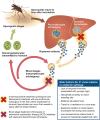Plasmodium vivax in Children: Hidden Burden and Conspicuous Challenges, a Narrative Review
- PMID: 36378465
- PMCID: PMC9868225
- DOI: 10.1007/s40121-022-00713-w
Plasmodium vivax in Children: Hidden Burden and Conspicuous Challenges, a Narrative Review
Abstract
There has been progress towards decreasing malaria prevalence globally; however, Plasmodium vivax has been less responsive to elimination efforts compared with Plasmodium falciparum. P. vivax malaria remains a serious public health concern in regions where it is the dominant species (South and South-East Asia, the Eastern Mediterranean region, and South America) and is increasingly recognized for its contribution to overall morbidity and mortality worldwide. The incidence of P. vivax decreases with increasing age owing to rapidly acquired clinical immunity and there is a disproportionate burden of P. vivax in infants and children, who remain highly vulnerable to severe disease, recurrence, and anemia with associated developmental impacts. Diagnosis is sometimes difficult owing to the sensitivity of diagnostic tests to detect low levels of parasitemia. Additionally, the propensity of P. vivax to relapse following reactivation of dormant hypnozoites in the liver contributes to disease recurrence in infants and children, and potentiates morbidity and transmission. The 8-aminoquinolines, primaquine and tafenoquine, provide radical cure (relapse prevention). However, the risk of hemolysis in patients with glucose-6-phosphate dehydrogenase (G6PD) deficiency necessitates testing prior to administration of 8-aminoquinolines, which has limited their uptake. Additional challenges include lack of availability of pediatric dose formulations and problems with adherence to primaquine owing to the length of treatment recommended. A paucity of data and studies specific to pediatric P. vivax malaria impacts the ability to deliver targeted interventions. It is imperative that P. vivax in infants and children be the focus of future research, control initiatives, and anti-malarial drug development.
Keywords: Children; Epidemiology; Malaria; Plasmodium vivax; Primaquine; Tafenoquine.
Plain language summary
Plasmodium vivax malaria is the most common type of malaria in South and South-East Asia, the Eastern Mediterranean region, and South America. Following a mosquito bite, the P. vivax parasite enters the blood and travels to the liver. It may cause malaria immediately or lie dormant and reactivate to cause relapses, weeks, months, or even years later. In P. vivax endemic regions, population immunity develops over time with repeated exposure to the parasite. Children bear the burden of disease since they have not acquired clinical immunity. Repeated relapses can cause anemia and affect growth and development. Radical cure refers to treatment of parasites in the blood and dormant parasites in the liver to prevent relapse. Until recently, primaquine was the only medicine approved for radical cure. When a primaquine regimen (7–14 days, depending on dose) is not completed, it is less effective. Additionally, there is no pediatric formulation currently available. Recently, tafenoquine, prescribed as a single dose, was approved for radical cure in children. Before radical cure, testing patients for deficiency of the enzyme glucose-6-phosphate dehydrogenase (G6PD) is necessary since patients with this deficiency may have rupturing or destruction of red blood cells. However, access to G6PD deficiency testing is limited, creating barriers to treatment. Eradication of P. vivax is challenging due to its ability to relapse, and the treatment challenges described above. It is imperative that future elimination efforts focus on improving access to curative treatments for infants and children who bear the burden of disease.
© 2022. The Author(s).
Similar articles
-
Optimal balance of benefit versus risk for tafenoquine in the treatment of Plasmodium vivax malaria.Malar J. 2024 May 13;23(1):145. doi: 10.1186/s12936-024-04924-z. Malar J. 2024. PMID: 38741094 Free PMC article. Review.
-
Tafenoquine Therapy and G6PD Genotype.2020 Oct 13. In: Pratt VM, Scott SA, Pirmohamed M, Esquivel B, Kattman BL, Malheiro AJ, editors. Medical Genetics Summaries [Internet]. Bethesda (MD): National Center for Biotechnology Information (US); 2012–. 2020 Oct 13. In: Pratt VM, Scott SA, Pirmohamed M, Esquivel B, Kattman BL, Malheiro AJ, editors. Medical Genetics Summaries [Internet]. Bethesda (MD): National Center for Biotechnology Information (US); 2012–. PMID: 33048487 Free Books & Documents. Review.
-
Global economic costs due to vivax malaria and the potential impact of its radical cure: A modelling study.PLoS Med. 2021 Jun 1;18(6):e1003614. doi: 10.1371/journal.pmed.1003614. eCollection 2021 Jun. PLoS Med. 2021. PMID: 34061843 Free PMC article.
-
[Role of primaquine in malaria control and elimination in French-speaking Africa].Bull Soc Pathol Exot. 2017 Aug;110(3):198-206. doi: 10.1007/s13149-017-0556-z. Epub 2017 Apr 17. Bull Soc Pathol Exot. 2017. PMID: 28417346 Review. French.
-
Addressing health equity for breastfeeding women: primaquine for Plasmodium vivax radical cure.Malar J. 2024 Sep 27;23(1):287. doi: 10.1186/s12936-024-05112-9. Malar J. 2024. PMID: 39334094 Free PMC article. Review.
Cited by
-
Plasmodium vivax Malaria in Duffy-Positive Patients in Rwanda.Am J Trop Med Hyg. 2023 Aug 7;109(3):621-623. doi: 10.4269/ajtmh.23-0143. Print 2023 Sep 6. Am J Trop Med Hyg. 2023. PMID: 37549894 Free PMC article.
-
Expression, Purification, and Characterization of Plasmodium vivax Lactate Dehydrogenase from Bacteria without Codon Optimization.Int J Mol Sci. 2023 Jul 4;24(13):11083. doi: 10.3390/ijms241311083. Int J Mol Sci. 2023. PMID: 37446261 Free PMC article.
-
Optimal balance of benefit versus risk for tafenoquine in the treatment of Plasmodium vivax malaria.Malar J. 2024 May 13;23(1):145. doi: 10.1186/s12936-024-04924-z. Malar J. 2024. PMID: 38741094 Free PMC article. Review.
-
Enhanced data quality to improve malaria surveillance in Papua, Indonesia.Malar J. 2025 Jun 4;24(1):177. doi: 10.1186/s12936-025-05358-x. Malar J. 2025. PMID: 40468325 Free PMC article.
-
Genetic diversity of merozoite surface protein-5 (MSP-5) of Plasmodium vivax isolates from Malaria patients in Iran.BMC Infect Dis. 2023 Nov 17;23(1):807. doi: 10.1186/s12879-023-08804-w. BMC Infect Dis. 2023. PMID: 37978446 Free PMC article.
References
-
- World malaria report . 20 years of global progress and challenges. Geneva: World Health Organization; 2020.
Publication types
LinkOut - more resources
Full Text Sources
Miscellaneous


